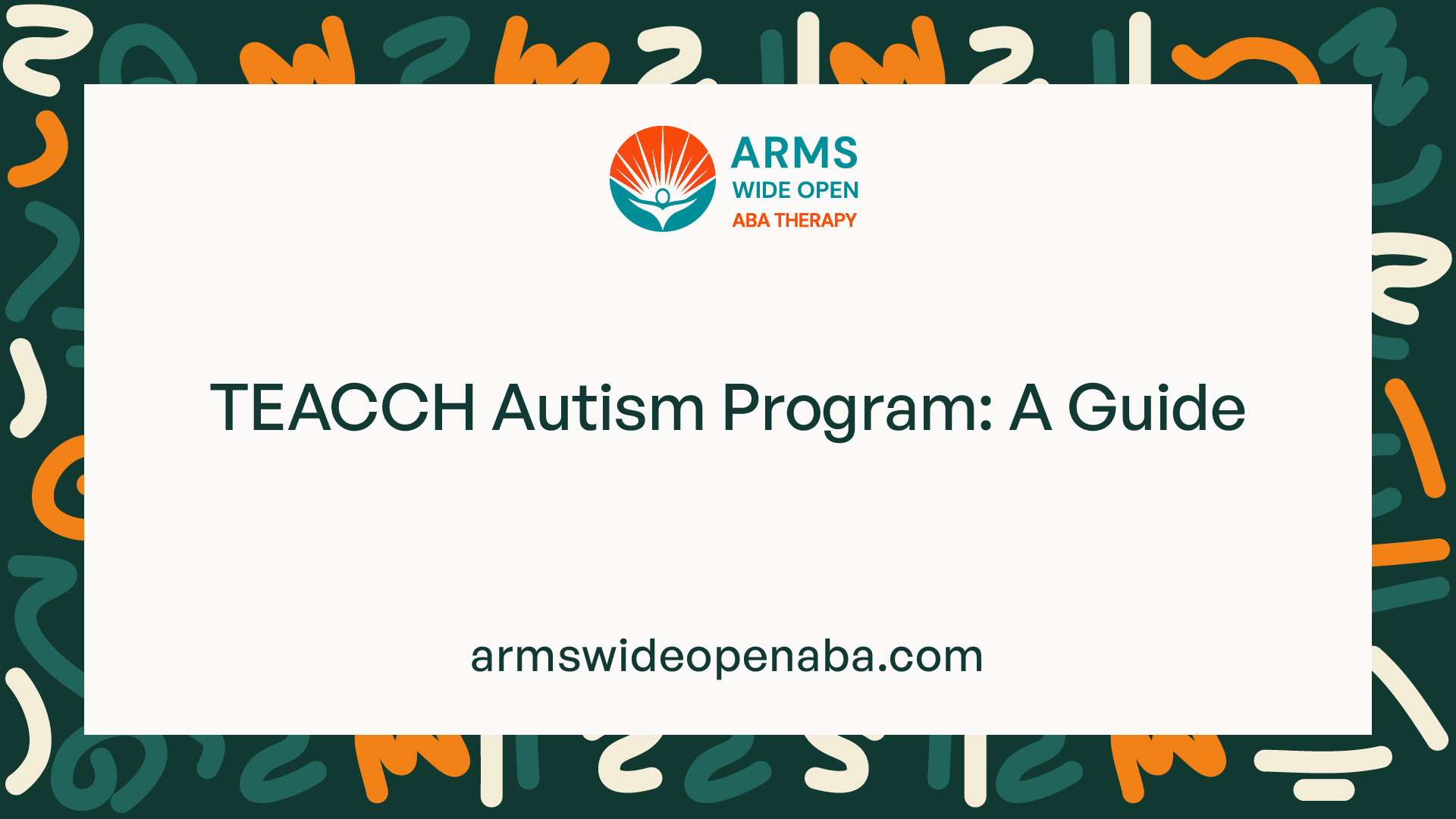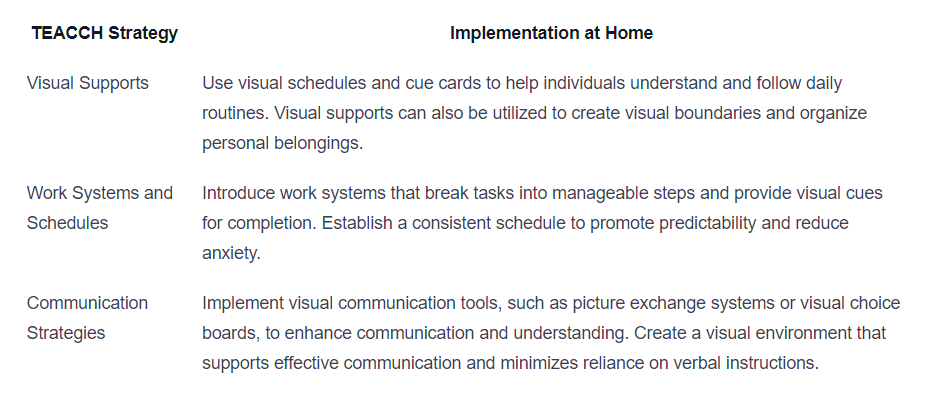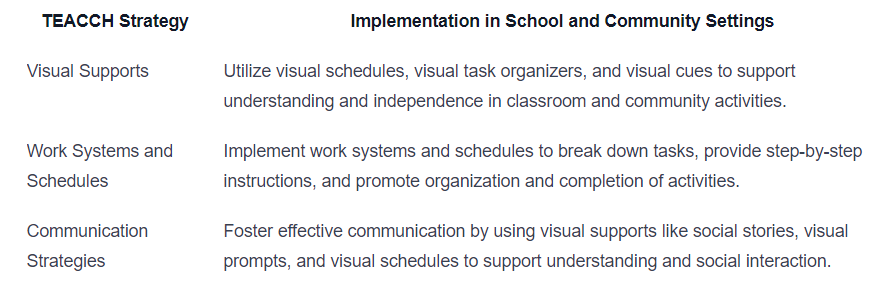TEACCH Autism Program: A Guide
Unlock the transformative power of the TEACCH Autism Program Guide. Discover structured teaching and individualized support for a brighter future.

Understanding TEACCH Autism Program
The TEACCH Autism Program is a comprehensive intervention approach designed to support individuals with Autism Spectrum Disorder (ASD) in various aspects of their lives. By providing structured teaching, individualized support, and evidence-based strategies, the TEACCH program aims to enhance the independence and quality of life for individuals with autism.

What is the TEACCH Program?
The TEACCH program, which stands for Treatment and Education of Autistic and Communication-related Handicapped Children, was developed in the 1970s by a team of professionals at the University of North Carolina. It is a person-centered approach that focuses on understanding and accommodating the unique strengths and challenges of individuals with autism.
The TEACCH program emphasizes the importance of structured teaching, a method that utilizes visual supports, clear schedules, and organized physical environments to promote learning and independence. By providing predictable and visually structured environments, individuals with autism can better understand and navigate their surroundings.
History and Background of TEACCH
The history of the TEACCH program dates back to the early 1970s when Dr. Eric Schopler and his colleagues at the University of North Carolina established the program. Their goal was to develop an intervention model that could effectively address the needs of individuals with autism and their families.
Over the years, the TEACCH program has evolved and expanded, becoming widely recognized and implemented both nationally and internationally. It has been instrumental in transforming the lives of individuals with autism, empowering them to reach their full potential and lead fulfilling lives.
Through ongoing research and collaboration with professionals, families, and individuals with autism, the TEACCH program continues to refine its strategies and interventions. This commitment to evidence-based practices ensures that the program remains at the forefront of autism intervention and support.
By gaining a deeper understanding of the TEACCH Autism Program and its history, we can appreciate the significance and impact of this approach in the lives of individuals with autism. In the following sections, we will explore the principles, components, implementation, and success stories associated with the TEACCH program, providing a comprehensive guide for those seeking support and guidance in the autism community.
Principles of TEACCH
The TEACCH Autism Program is built upon certain principles that guide its approach to supporting individuals with autism. These principles emphasize the importance of a structured teaching approach and individualized support and intervention.
Structured Teaching Approach
A key principle of the TEACCH Autism Program is the structured teaching approach. This approach recognizes that individuals with autism often thrive in structured environments that provide clear expectations and routines. The structured teaching approach involves:
- Physical Structure: Creating an organized and visually clear physical environment is crucial. This involves arranging the physical space in a way that supports individual learning and reduces distractions. Visual cues, such as visual schedules and labels, are used to provide visual structure and support understanding.
- Visual Supports: Visual supports play a significant role in structured teaching. Visual supports help individuals with autism understand and navigate their environment. These may include visual schedules, visual task lists, and visual instructions. By using visual supports, individuals can better comprehend and follow daily routines and activities.
- Work Systems and Schedules: Work systems and schedules are essential components of the structured teaching approach. Work systems provide individuals with a clear organization of tasks, breaking them down into manageable steps. This helps promote independence and reduces anxiety. Visual schedules outline the sequence of activities and provide predictability, enhancing understanding and reducing uncertainty.
Individualized Support and Intervention
In addition to the structured teaching approach, the TEACCH Autism Program emphasizes the significance of individualized support and intervention. This principle recognizes that each individual with autism has unique strengths, challenges, and learning styles. Individualized support and intervention involve:
- Assessment and Planning: A comprehensive assessment is conducted to understand the individual's strengths, preferences, and areas of need. Based on the assessment, a personalized plan is developed to address specific goals and objectives. This plan takes into account the individual's learning style, communication abilities, and sensory preferences.
- Adaptive Strategies: Individualized support involves implementing adaptive strategies that are tailored to the specific needs of the individual. These strategies may include visual supports, communication strategies, social skills training, and sensory accommodations. The goal is to provide the necessary tools and techniques that support the individual's learning and development.
- Collaboration and Teamwork: Individualized support is a collaborative effort involving various professionals, caregivers, and educators. The TEACCH Autism Program promotes a multidisciplinary approach, encouraging teamwork and communication among all involved parties. This collaboration ensures consistency and maximizes the effectiveness of the support and intervention provided.
By following the principles of a structured teaching approach and providing individualized support and intervention, the TEACCH Autism Program offers a comprehensive framework for empowering individuals with autism and promoting their overall development and independence.
Components of the TEACCH Program
The TEACCH Autism Program incorporates various components that work together to support individuals with autism spectrum disorder (ASD). These components are designed to create a structured and supportive environment, enabling individuals with ASD to thrive and reach their full potential. Let's explore three key components of the TEACCH program: physical structure and visual supports, work systems and schedules, and communication strategies.
Physical Structure and Visual Supports
The physical structure of the environment plays a crucial role in the TEACCH program. It is designed to minimize distractions and create a calm and organized space that promotes learning and independence. Some key elements of the physical structure include:
- Visual Supports: Visual supports are visual cues, such as schedules, labels, and visual instructions, that help individuals with ASD understand expectations and navigate daily tasks. These visual supports can be in the form of pictures, symbols, or written words. They provide a visual structure that aids in comprehension and reduces anxiety.
- Structured Work Areas: Work areas within the TEACCH program are carefully organized and visually defined to provide individuals with clear boundaries and guidelines. These structured work areas help individuals focus on specific tasks, enhance their understanding of work expectations, and increase their independence.
Work Systems and Schedules
Work systems and schedules are essential components of the TEACCH program that promote organization, independence, and task completion. These components help individuals with ASD understand and follow a set routine, manage their time effectively, and transition between activities. Key aspects of work systems and schedules include:
- Task Organization: Work systems involve breaking down tasks into manageable steps and providing visual supports that guide individuals through each step. This visual structure enhances understanding, reduces frustration, and promotes independence in completing tasks.
- Visual Schedules: Visual schedules outline the sequence of activities or tasks using visual cues. These schedules help individuals with ASD anticipate and prepare for upcoming activities, reducing anxiety and enhancing predictability. Visual schedules can be in the form of pictures, symbols, or written words, depending on the individual's preferences and abilities.
Communication Strategies
Effective communication strategies are integral to the TEACCH program, as they facilitate understanding, social interaction, and self-expression for individuals with ASD. Some important communication strategies within the program include:
- Visual Communication: Visual communication methods, such as using visual supports, gestures, and visual aids, are emphasized in the TEACCH program. These strategies help individuals with ASD better comprehend and express their needs, ideas, and emotions.
- Social Communication Skills: The TEACCH program focuses on developing and strengthening social communication skills in individuals with ASD. This includes teaching and practicing skills such as turn-taking, initiating and maintaining conversations, understanding nonverbal cues, and building social relationships.
The components discussed above are essential elements of the TEACCH Autism Program, working together to create an environment that supports individuals with ASD in various aspects of their daily lives. By implementing physical structure and visual supports, work systems and schedules, and effective communication strategies, individuals with ASD can enhance their independence, learning, and overall well-being within the TEACCH program.
Implementation in Daily Life
The TEACCH Autism Program provides valuable strategies and techniques that can be applied in daily life to support individuals with autism. Whether at home, school, or within the community, implementing TEACCH strategies can make a significant difference in enhancing the lives of individuals on the autism spectrum.
Applying TEACCH Strategies at Home
Implementing TEACCH strategies at home can create a structured and supportive environment for individuals with autism. By incorporating visual supports, establishing routines, and promoting independence, families can create a nurturing space that fosters growth and development.

By incorporating these TEACCH strategies at home, families can create a structured and supportive environment that promotes independence, reduces anxiety, and enhances daily routines for individuals with autism.
TEACCH in School and Community Settings
The TEACCH Autism Program is not limited to the home environment. It is also highly applicable in school and community settings, providing valuable tools for educators, support personnel, and community members to effectively support individuals with autism.

By incorporating TEACCH strategies in school and community settings, educators, support personnel, and community members can create inclusive environments that promote learning, independence, and social engagement for individuals with autism.
Implementing TEACCH strategies in daily life, whether at home, school, or in the community, empowers individuals with autism to thrive and reach their full potential. By providing structure, support, and effective communication tools, the TEACCH Autism Program serves as a guide for transforming lives and enhancing the overall well-being of individuals on the autism spectrum.
Success Stories with TEACCH
The TEACCH Autism Program has had a profound impact on the lives of individuals with autism and their families. Through its structured teaching approach and individualized support, TEACCH has helped countless individuals navigate their daily lives more effectively. In this section, we will explore real-life examples of the impact of TEACCH and share testimonials and feedback from those who have benefited from the program.
Real-life Examples of TEACCH Impact
TEACCH has transformed the lives of individuals with autism by equipping them with the necessary skills and strategies to thrive in various settings. Here are a few examples of how TEACCH has made a difference:

These real-life examples highlight the positive impact of TEACCH on individuals with autism, demonstrating the effectiveness of the program in addressing their unique needs and promoting their overall development.
Testimonials and Feedback
The impact of TEACCH can also be seen through the testimonials and feedback of individuals who have participated in the program. Here are some examples:

These testimonials and feedback highlight the positive experiences and outcomes individuals have had with TEACCH, underscoring the program's effectiveness in empowering individuals with autism and enhancing their quality of life.
The success stories and testimonials shared here are just a glimpse of the numerous individuals who have benefited from the TEACCH Autism Program. Through its commitment to structured teaching, individualized support, and evidence-based strategies, TEACCH continues to make a lasting impact on the lives of individuals with autism and their families.
Resources and Further Support
As you explore the TEACCH Autism Program and its potential benefits, it's important to know where to access the program and find additional resources and training opportunities.
Accessing TEACCH Programs
The TEACCH Autism Program is widely recognized and implemented across various locations. To access TEACCH programs, you can reach out to local autism centers, educational institutions, or community organizations that specialize in autism support. They can provide information on available TEACCH programs in your area and guide you through the enrollment process.
Furthermore, you may find it helpful to consult with professionals in the field of autism, such as psychologists, therapists, or educators. They can offer insights and recommendations tailored to your specific needs and circumstances.
Additional Reading and Training Opportunities
In addition to accessing TEACCH programs, there are various resources and training opportunities available to enhance your understanding and implementation of the TEACCH Autism Program.
Books and Publications
There are several books and publications that provide in-depth information on TEACCH and its strategies. These resources can be valuable references for parents, caregivers, educators, and professionals working with individuals on the autism spectrum. Here are a few examples:

Online Courses and Workshops
Online courses and workshops provide convenient opportunities to learn about the TEACCH Autism Program from the comfort of your own home. These courses are often designed for parents, caregivers, educators, and professionals seeking to expand their knowledge and skills. Some organizations offer both introductory and advanced courses, covering various aspects of the TEACCH approach.
Professional Training and Certification
For individuals interested in becoming certified TEACCH practitioners, professional training and certification programs are available. These programs provide comprehensive training on the principles and implementation of the TEACCH Autism Program. Completion of these programs can enhance your ability to support individuals with autism and open up career opportunities in the field.
By accessing TEACCH programs and utilizing additional resources and training opportunities, you can further develop your understanding of the program and its strategies. This will enable you to provide effective support and intervention to individuals on the autism spectrum, helping them thrive and reach their full potential.
Sources
https://raisingchildren.net.au/autism/therapies-guide/teacch
https://www.autismspeaks.org/teacch
https://www.autismparentingmagazine.com/asd-teacch-method-works/
Similar articles
We’re here to help you

Our team is here to assist you in this process. Contact us for any assistance.
it’s easy to apply
We Accept Most Insurances
Our in-network insurance partnerships make ABA therapy more accessible to families throughout our service areas.







Our Insurance Process
We'll request your insurance details to help us verify your plan's coverage for ABA therapy. Once we've received this information, we'll walk you through your benefits, including copayments, deductibles and out-of-pocket maximums, so you know what to expect in advance.
Our team will then handle the preauthorization and all the necessary paperwork.
.svg)





















.jpeg)


































.jpeg)




.jpeg)







.jpeg)











.jpeg)
















